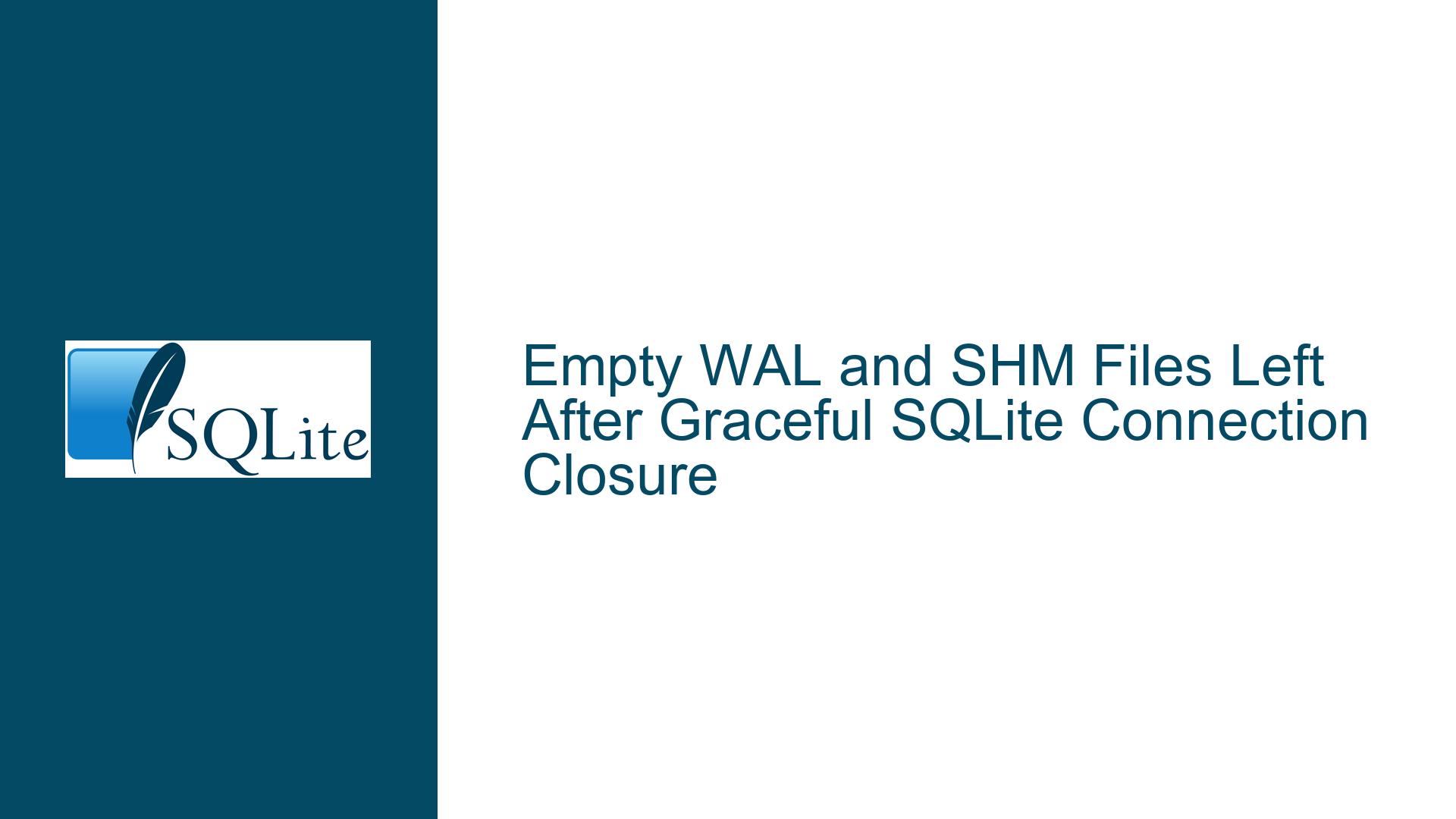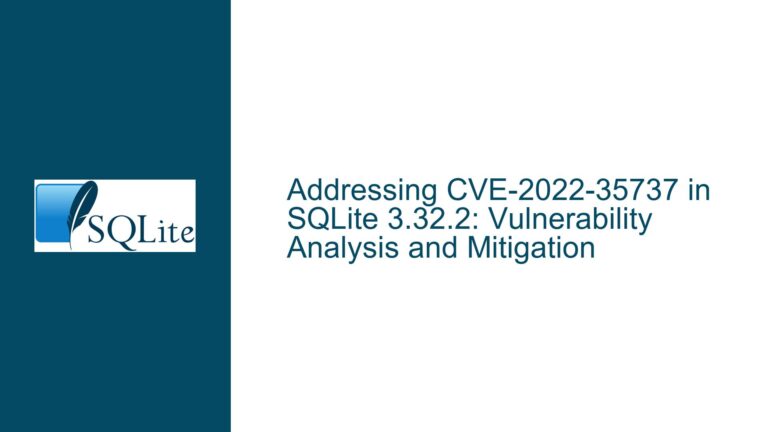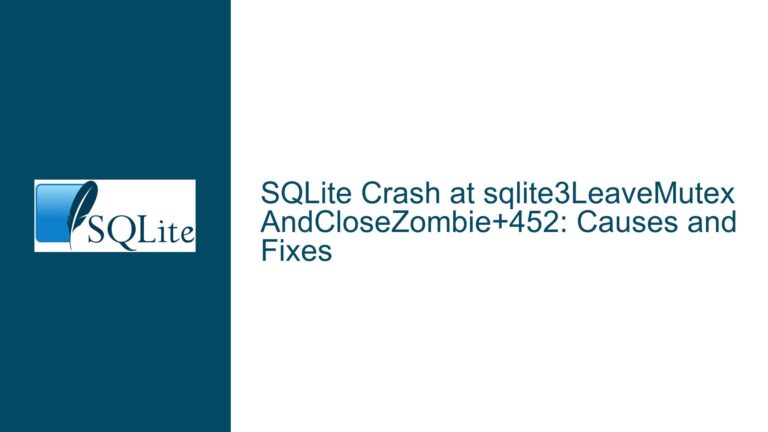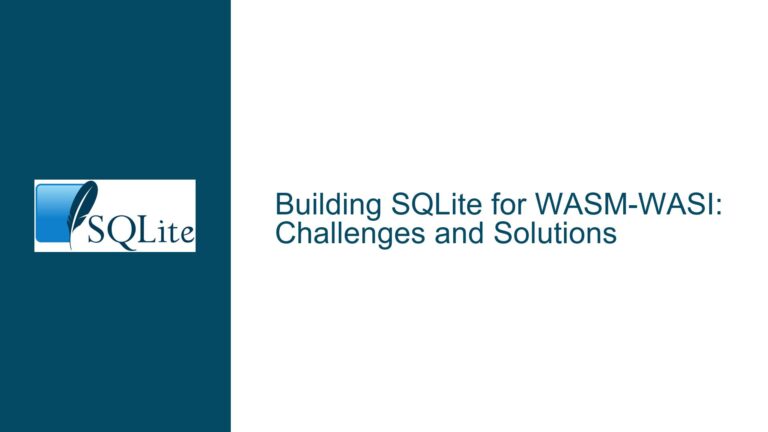Empty WAL and SHM Files Left After Graceful SQLite Connection Closure
Empty WAL and SHM Files Persisting After Database Backup
When using SQLite in WAL (Write-Ahead Logging) mode with multiple connections (one per thread), a common issue arises where empty WAL (-wal) and shared-memory (-shm) files are left on disk even after a graceful connection closure. This occurs particularly when using the sqlite3_backup API to create a backup of an active database connection. The -wal file is expected to be empty upon a graceful shutdown, but the persistence of these files can be confusing and may lead to unnecessary clutter or concerns about database integrity.
The core of the issue lies in the behavior of SQLite’s WAL mode, which inherently relies on these files for its operation. The -wal file contains the write-ahead log, while the -shm file acts as an index to quickly locate specific entries within the WAL file. These files are essential for WAL mode, even in single-process, multi-threaded environments where shared memory might seem unnecessary. The persistence of these files after a backup operation is a byproduct of SQLite’s design to ensure data integrity and concurrency control.
The primary questions raised are:
- Can SQLite be configured to automatically delete empty journal files?
- Can SQLite be configured to avoid using shared-memory files?
These questions stem from a misunderstanding of the role of shared memory in SQLite’s WAL mode. Shared memory is not solely for inter-process communication; it is also crucial for intra-process concurrency control in multi-threaded environments. The -shm file is indispensable for WAL mode, regardless of whether the database is accessed by multiple processes or multiple threads within a single process.
Misconceptions About Shared Memory and WAL Mode
A significant misconception in this scenario is the belief that shared memory is only necessary for inter-process communication. This leads to the assumption that in a single-process, multi-threaded application, shared memory is redundant. However, SQLite’s WAL mode uses the -shm file to manage concurrent access to the WAL file, even within a single process. The -shm file contains metadata that allows multiple threads to coordinate their access to the WAL file efficiently. Without this file, SQLite would need to read the entire WAL file to locate specific entries, which would be highly inefficient.
Another misconception is that the -wal and -shm files are only relevant when multiple applications access the same database. In reality, these files are essential for any multi-threaded application using WAL mode, even if the database is accessed exclusively by a single application. The WAL mode is designed to handle concurrent access, and the -shm file is a critical component of this design.
The persistence of these files after a graceful shutdown is not a bug but a feature. SQLite retains these files to ensure that they are available for future connections. However, if the database is closed gracefully and no further connections are expected, these files can be safely deleted. The challenge is that SQLite does not automatically delete these files in such scenarios.
Configuring SQLite to Manage WAL and SHM Files
To address the issue of empty -wal and -shm files persisting after a graceful shutdown, several approaches can be taken. These include configuring SQLite to delete empty journal files, switching out of WAL mode, and understanding the implications of read-only connections.
Automatically Deleting Empty Journal Files
SQLite does not provide a built-in configuration option to automatically delete empty -wal and -shm files after a graceful shutdown. However, these files can be manually deleted if it is certain that no further connections will be made to the database. This can be done programmatically by the application after closing the database connection. For example, after calling sqlite3_backup_finish(), the application can check if the -wal file is empty and delete it if necessary. Similarly, the -shm file can be deleted if it is no longer needed.
Switching Out of WAL Mode
If the persistence of -wal and -shm files is undesirable, one option is to switch the database out of WAL mode. This can be done using the PRAGMA journal_mode command. For example, executing PRAGMA journal_mode = delete; will switch the database to rollback journal mode, which does not use -wal or -shm files. However, this approach has trade-offs. Rollback journal mode is less efficient for concurrent access and can lead to more contention between threads. Additionally, switching journal modes requires write access to the database, which may not be possible if the database is opened in read-only mode.
Handling Read-Only Connections
For read-only connections, the persistence of -wal and -shm files is generally not an issue. However, if the database was previously used in WAL mode, these files will still be present. In such cases, it is important to understand that read-only connections do not modify the database and therefore do not need to interact with the -wal and -shm files. However, these files must still be present if the database is accessed in WAL mode by other connections.
If the database is opened in read-only mode using the SQLITE_OPEN_READONLY flag, the PRAGMA journal_mode and PRAGMA synchronous settings have no effect. This is because these settings only affect write operations, and a read-only connection cannot perform any writes. Therefore, there is no need to configure these settings for read-only connections.
Best Practices for Managing WAL and SHM Files
To effectively manage -wal and -shm files, consider the following best practices:
Understand the Role of WAL and SHM Files: Recognize that these files are essential for WAL mode and are not merely artifacts of inter-process communication. They play a critical role in managing concurrent access to the database, even within a single process.
Manually Delete Unnecessary Files: If it is certain that no further connections will be made to the database, the -wal and -shm files can be manually deleted after closing the connection. This should be done with caution, as deleting these files while the database is still in use can lead to data corruption.
Consider Switching Journal Modes: If the persistence of -wal and -shm files is a significant concern, consider switching the database to a different journal mode, such as rollback journal mode. Be aware of the trade-offs in terms of performance and concurrency.
Use Read-Only Connections Appropriately: For read-only connections, ensure that the database is not being modified by other connections. If the database is exclusively read-only, the -wal and -shm files can be safely ignored, as they will not be used.
Monitor File Sizes: Regularly monitor the size of the -wal and -shm files. If these files grow excessively large, it may indicate a problem with the application’s use of the database, such as long-running transactions or excessive concurrency.
By following these best practices, you can effectively manage the -wal and -shm files in SQLite and ensure that your database operates efficiently and reliably. Understanding the role of these files and how they interact with your application’s connection patterns is key to avoiding unnecessary issues and maintaining a clean and efficient database environment.






